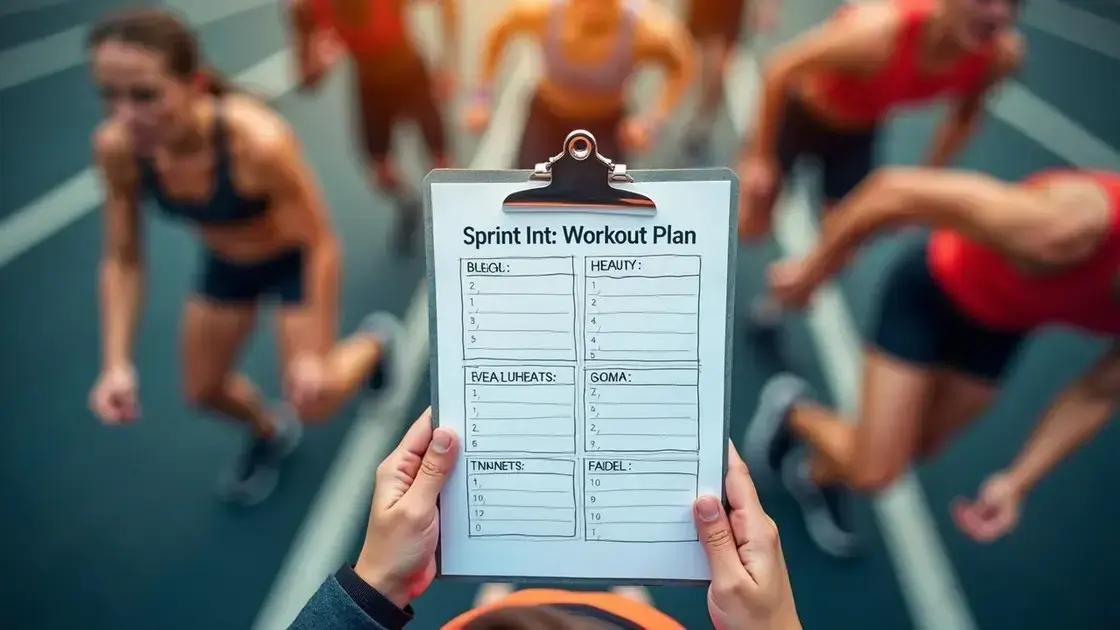Learn how to develop explosive speed with sprint intervals by understanding their structure, benefits, and techniques. Create an effective workout with tailored intervals and proper recovery to enhance your athletic performance and overall speed.
Are you looking to enhance your athletic performance? Sprint intervals are the solution. By incorporating high-intensity sprinting into your training, you can develop explosive speed, boost your agility, and improve overall athleticism. This article will guide you through understanding sprint intervals, their benefits, effective techniques, and how to create a personalized sprint interval workout that will transform your speed.
Understanding Sprint Intervals

Sprint intervals are bursts of high-intensity running followed by periods of rest or low-intensity activity. This training method is designed to improve speed and enhance overall athletic performance.
To understand sprint intervals, consider the basic structure. Typically, you sprint at maximum effort for a short duration, often ranging from 20 seconds to 1 minute. After each sprint, a recovery phase follows, where you either walk or jog lightly for a set time, usually two to four times the duration of the sprint.
How Sprint Intervals Work
The principle behind sprint intervals is simple: by pushing your body to its limits during sprints, you recruit fast-twitch muscle fibers. These fibers are essential for explosive movements. The recovery phase allows your heart rate to lower before the next high-intensity effort. This alternation between effort and recovery challenges your body, leading to improved speed and stamina over time.
Energy Systems and Benefits
Sprint intervals primarily utilize the anaerobic energy system, which allows athletes to perform at high intensity for short periods. This leads to significant adaptations in muscle composition and increased aerobic capacity. Additionally, sprint intervals can help burn fat and improve metabolic rate, making them an efficient workout choice.
Overall, incorporating sprint intervals into your training can be a game-changer. They not only improve speed but also offer cardiovascular benefits, enhancing your overall athletic capabilities.
Benefits of Developing Speed

Developing speed is crucial for athletes across various sports. Improved speed not only influences performance but also increases overall competitiveness. Here are some key benefits associated with enhancing your speed:
Increased Athletic Performance
When you develop speed, you improve your ability to perform in your sport. Whether you play soccer, basketball, or track, a quicker start, faster sprint, and sharper movements can give you an edge over your opponents.
Enhanced Agility
Speed training often enhances agility. Quick direction changes and response times are essential in many sports. Developing speed allows for more effective and efficient movements on the field or court.
Better Endurance
While speed is a short-duration effort, it can improve your overall endurance. By training at high intensities with sprint intervals, your heart and lungs become more efficient, enabling you to maintain high performance longer during games.
Boosted Confidence
As you improve your speed through training, you build confidence in your abilities. This self-assurance can translate into better performance in practice and competition, leading to a more positive athletic experience.
Overall, developing speed through techniques like sprint intervals has numerous advantages that can enhance your athletic journey and performance.
Techniques for Sprint Intervals

To effectively enhance your speed, several techniques can be incorporated into your sprint intervals. Here are some key methods to consider:
1. Start with a Warm-Up
Before any sprint training, a warm-up is essential. Begin with light jogging or dynamic stretches to prepare your muscles and joints. This reduces the risk of injury and improves performance during high-intensity efforts.
2. Determine Sprint Duration
Choose appropriate sprint durations based on your fitness level. Beginners may start with 20-30 seconds of sprinting, while more advanced athletes can push for 60 seconds or longer. Ensure your sprint intensity is maximal during this phase.
3. Proper Recovery
During the recovery phase, use a ratio of 1:2 or 1:3. For example, if you sprint for 30 seconds, rest for 60 to 90 seconds. Active recovery, like walking or light jogging, can help to maintain blood flow and prepare for the next sprint.
4. Incorporate Variety
Mix up your intervals to prevent boredom and challenge your body differently. Try hill sprints, fartlek training, or sprinting on different surfaces to improve strength and speed. Incorporating drills such as agility ladders can also help boost your overall speed and coordination.
Implementing these techniques into your training can lead to significant improvements in your sprinting ability, giving you an edge in your athletic performance.
Creating Your Sprint Interval Workout

Creating a sprint interval workout is essential for developing explosive speed. Here’s a step-by-step guide to designing your own effective routine:
1. Define Your Goals
Before starting, determine what you want to achieve. Are you training for a specific sport, increasing speed, or improving endurance? Setting clear goals will help you design an effective workout.
2. Choose Your Location
You can perform sprint intervals on a track, field, or even a flat open space. Make sure the area is safe and free from obstacles. This allows you to sprint freely and avoid injuries.
3. Plan Sprint Intervals
Decide on the total length of your workout and the number of intervals. A common setup might be to do 6-10 sprints of 30 seconds each, followed by a recovery period of 60-120 seconds. Adjust these based on your fitness level.
4. Incorporate a Warm-Up and Cool Down
Always begin with a warm-up, like a 10-minute jog and dynamic stretches, to prepare your body for intense activity. After completing your sprints, cool down with light jogging and static stretching to aid recovery.
5. Monitor Your Progress
Keep track of your sprint times and how you feel during workouts. Monitoring progress ensures you can make adjustments and improvements over time. Consider using a fitness app or a stopwatch.
By following these steps, you can create an effective sprint interval workout that helps you develop explosive speed and enhances your athletic abilities.
Unlock Your Potential with Sprint Intervals
Developing explosive speed through sprint intervals is an effective training method for athletes at all levels. By understanding the fundamentals of sprint intervals, recognizing the benefits of speed, and implementing various techniques, you can significantly enhance your performance.
Creating a personalized sprint interval workout tailored to your needs will further your progress. As you commit to this training regimen, you’ll notice improvements not only in your speed but also in your overall athletic abilities.
Stay consistent, track your results, and adjust as necessary to reach your goals. Embrace the journey of speed development, and watch your performance reach new heights.
FAQ – Frequently Asked Questions About Developing Speed with Sprint Intervals
What are sprint intervals?
Sprint intervals are short bursts of high-intensity running followed by periods of rest or low-intensity activity, designed to improve speed and stamina.
How do sprint intervals benefit my speed?
They enhance your athletic performance by recruiting fast-twitch muscle fibers, improving cardiovascular health, and increasing your overall agility.
What techniques should I use when training with sprint intervals?
Begin with a proper warm-up, choose appropriate sprint durations, use efficient recovery periods, and incorporate variety in your workouts.
How can I create an effective sprint interval workout?
Define your goals, select a training location, plan sprint intervals and recovery times, and include warm-up and cool-down routines.
How often should I do sprint interval training?
Aim for 2-3 times a week, allowing adequate recovery between sessions to maximize performance and prevent injury.
Is sprint interval training suitable for beginners?
Yes, beginners can perform sprint intervals by starting at lower intensities and gradually increasing the duration and intensity as fitness improves.













